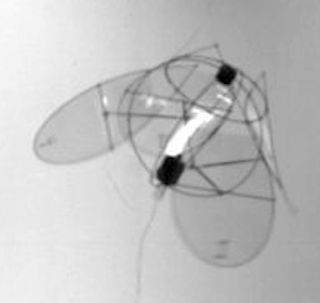
Flying-Robot
Air and water are both fluids, after all — the latter is just thicker.
Another issue, though, was stability. Flying insects — flies for instance — are inherently unstable. The fly has to do a lot of fine control. Nature has equipped the fly with some pretty sophisticated systems in its brain. But cramming all that software into a package small enough to fly isn’t easy. Hence the move to jellyfish as a model.
Ristroph’s robot flies by flapping four wings that are arranged around the robot’s “waist.” The wings move up and down and it looks like a jellyfish, though strictly speaking the aerodynamics are probably a bit more like a moth.
Ristroph’s robot is just two grams and about four inches across, and the ‘bot can hover and fly. The whole thing is a lot more stable than a fly-wing design would be, so you needn’t take up valuable space with flight control hardware, or shield it with any kind of outer shell, as in this design.
It’s not a fully autonomous robot yet, though. It is attached to a tether as it hasn’t got its own power source. But Ristroph noted in a press release that the size of the robot only depends on how big and powerful the motor is. On other words, if you don’t need a lot of power, the motor can be relatively small. He plans to work on making more autonomous ‘bots, and smaller ones, that can fly around and squeeze into small spaces.
Ristroph is presenting his work at the APS Division of Fluid Dynamics Meeting in Pittsburgh on Nov. 24.
Ristroph’s robot flies by flapping four wings that are arranged around the robot’s “waist.” The wings move up and down and it looks like a jellyfish, though strictly speaking the aerodynamics are probably a bit more like a moth.
Ristroph’s robot is just two grams and about four inches across, and the ‘bot can hover and fly. The whole thing is a lot more stable than a fly-wing design would be, so you needn’t take up valuable space with flight control hardware, or shield it with any kind of outer shell, as in this design.
It’s not a fully autonomous robot yet, though. It is attached to a tether as it hasn’t got its own power source. But Ristroph noted in a press release that the size of the robot only depends on how big and powerful the motor is. On other words, if you don’t need a lot of power, the motor can be relatively small. He plans to work on making more autonomous ‘bots, and smaller ones, that can fly around and squeeze into small spaces.
Ristroph is presenting his work at the APS Division of Fluid Dynamics Meeting in Pittsburgh on Nov. 24.












.jpg)
No comments:
Post a Comment